Related Research Articles

Amphibole is a group of inosilicate minerals, forming prism or needlelike crystals, composed of double chain SiO
4 tetrahedra, linked at the vertices and generally containing ions of iron and/or magnesium in their structures. Its IMA symbol is Amp. Amphiboles can be green, black, colorless, white, yellow, blue, or brown. The International Mineralogical Association currently classifies amphiboles as a mineral supergroup, within which are two groups and several subgroups.

Actinolite is an amphibole silicate mineral with the chemical formula Ca2(Mg4.5-2.5Fe2+0.5-2.5)Si8O22(OH)2.
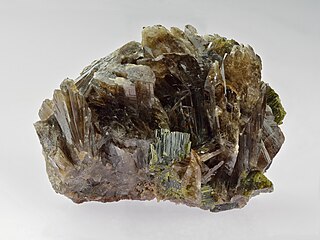
Axinite is a brown to violet-brown, or reddish-brown bladed group of minerals composed of calcium aluminium boro-silicate, (Ca,Fe,Mn)3Al2BO3Si4O12OH. Axinite is pyroelectric and piezoelectric.
Hapkeite is a mineral discovered in the Dhofar 280 meteorite found in 2000 in Oman on the Arabian peninsula. The meteorite is believed to originate from the Moon; specifically, it appears to be a fragment of lunar highland breccia. Hapkeite's composition is of silicon and iron, and it is similar to other silicon-iron minerals found on Earth. An impact on the Moon is thought to have launched the partially molten or vaporized material into orbit.

Forsterite (Mg2SiO4; commonly abbreviated as Fo; also known as white olivine) is the magnesium-rich end-member of the olivine solid solution series. It is isomorphous with the iron-rich end-member, fayalite. Forsterite crystallizes in the orthorhombic system (space group Pbnm) with cell parameters a 4.75 Å (0.475 nm), b 10.20 Å (1.020 nm) and c 5.98 Å (0.598 nm).
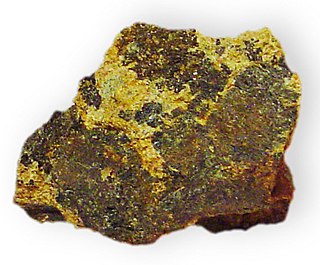
Cummingtonite is a metamorphic amphibole with the chemical composition (Mg,Fe2+
)
2(Mg,Fe2+
)
5Si
8O
22(OH)
2, magnesium iron silicate hydroxide.

Aegirine is a member of the clinopyroxene group of inosilicate minerals. Aegirine is the sodium endmember of the aegirine-augite series. Aegirine has the chemical formula NaFeSi2O6 in which the iron is present as Fe3+. In the aegirine-augite series the sodium is variably replaced by calcium with iron(II) and magnesium replacing the iron(III) to balance the charge. Aluminium also substitutes for the iron(III). Acmite is a fibrous, green-colored variety.

Cronstedtite is a complex iron silicate mineral belonging to the serpentine group of minerals. Its chemical formula is Fe2+
2Fe3+
(Si,Fe3+
O
5)(OH)
4.

Hisingerite is an iron(III) phyllosilicate mineral with formula FeIII2Si2O5(OH)4 · 2 H2O. A black or dark brown, lustrous secondary mineral, it is formed by the weathering or hydrothermal alteration of other iron silicate and sulfide minerals.
Ferrosilicon is an alloy of iron and silicon with a typical silicon content by weight of 15–90%. It contains a high proportion of iron silicides.
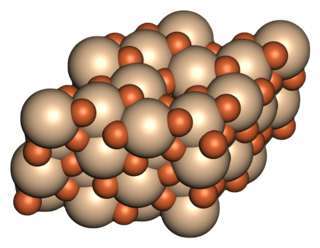
Xifengite (Fe5Si3) is a rare metallic iron silicide mineral. The crystal system of xifengite is hexagonal. It has a specific gravity of 6.45 and a Mohs hardness of 5.5. It occurs as steel gray inclusions within other meteorite derived nickel iron mineral phases.
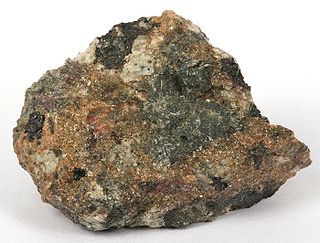
Nelenite is a rare manganese iron phyllosilicate arsenate mineral found in Franklin Furnace, New Jersey.
Brownleeite is a silicide mineral with chemical formula MnSi. It was discovered by researchers of the Johnson Space Center in Houston while analyzing the Pi Puppid particle shower of the comet 26P/Grigg-Skjellerup. The only other known natural manganese silicide is mavlyanovite, Mn5Si3.
Suessite is a rare iron silicide mineral with chemical formula: Fe3Si. The mineral was named after Professor Hans E. Suess. It was discovered in 1982 during the chemical analysis of The North Haig olivine pigeonite achondrite (ureilite). It is a cream white color in reflected light, and ranges in size from 1 μm "blebs" to elongated grains that can reach up to 0.45 cm in length. This mineral belongs in the isometric crystal class. The isometric class has crystallographic axes that are all the same length and each of the three axes perpendicular to the other two. It is isotropic, has a structural type of DO3 and a crystal lattice of BiF3.
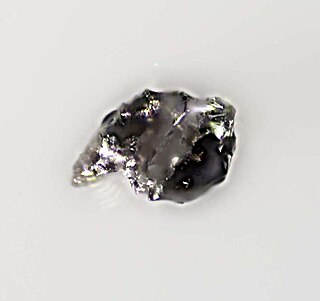
Linzhiite is an iron silicide mineral with the formula FeSi2. It was discovered in the 1960s in Donetsk Oblast in Soviet Union, and named ferdisilicite, but was not approved by the International Mineralogical Association. It was later rediscovered near Linzhi in Tibet. Linzhiite occurs together with other rare iron silicide minerals, xifengite (Fe5Si3) and naquite (FeSi).
Diiron silicide (Fe2Si) is an intermetallic compound, a silicide of iron. It occurs in cosmic dust as the mineral hapkeite. It is a non-stoichiometric compound where the Fe:Si ratio depends on the sample preparation. A related compound Fe5Si3 occurs in nature as the mineral xifengite.

Iron monosilicide (FeSi) is an intermetallic compound, a silicide of iron that occurs in nature as the rare mineral naquite. It is a narrow-bandgap semiconductor with a room-temperature electrical resistivity of ca. 10,000 Ohm·cm and unusual magnetic properties at low temperatures. FeSi has a cubic crystal lattice with no inversion center; therefore its magnetic structure is helical, with right-hand and left-handed chiralities.
Mavlyanovite is a manganese-silicon mineral with formula Mn5Si3. It was named after Gani Mavlyanov, an Uzbek geologist who lived from 1910 to 1988.
Phosphide silicides or silicide phosphides or silicophosphides are compounds containing anions composed of silicide (Si4−) and phosphide (P3−). They can be considered as mixed anion compounds. They are distinct from the phosphidosilicates, which have the phosphorus bonded to the silicon. Related compounds include the phosphide carbides, germanide phosphides, nitride silicides, and antimonide silicides.
References
- ↑ Warr, L.N. (2021). "IMA–CNMNC approved mineral symbols". Mineralogical Magazine. 85: 291–320.
- ↑ Naquite. Mindat
- 1 2 Fersilicite. webmineral.com